Sometimes lightning protection system designs cannot be implemented using standard solutions. In such cases, unique technical developments are used, and sometimes an outstanding creative approach. Let's look at examples when lightning protection has become a serious challenge to the ingenuity of engineers. Experience in their implementation can be useful in different conditions.
Communication tower lightning protection
In the suburbs of Orlando, Florida, USA, there is a communication tower that is used to communicate with 911 emergency response rescue service. Thunderstorms occur in the region 130 days a year - this is a lot, and comparable to the highlands. During the period of greatest thunderstorm activity from May to October, lightning strikes the tower once or twice a month.
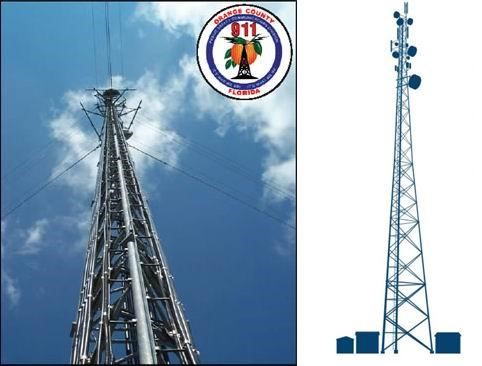
Communication towers are at increased risk of lightning damage
10 years ago during the construction of the tower it was equipped with lightning protection that met all the standards of that time. However, during the operation, lightning strikes caused huge damage to the tower. Worst of all, after another lightning strike to the tower, rescuers often remained without important communication channels. This happened during the disaster, when the 911 service is working most intensively, trying to cope with the effects of bad weather in a region with a population of almost 1 million people. The state spent $ 30 million for the construction of the entire communications system with 11 towers.
The problem is that the tower is tall (85 m) and equipped with a lot of sensitive equipment, including a 28-channel radio system with 11 transmitters. Lightning constantly disables transmitters priced at several tens of thousands of dollars. The damage was $ 100-200 thousand annually.
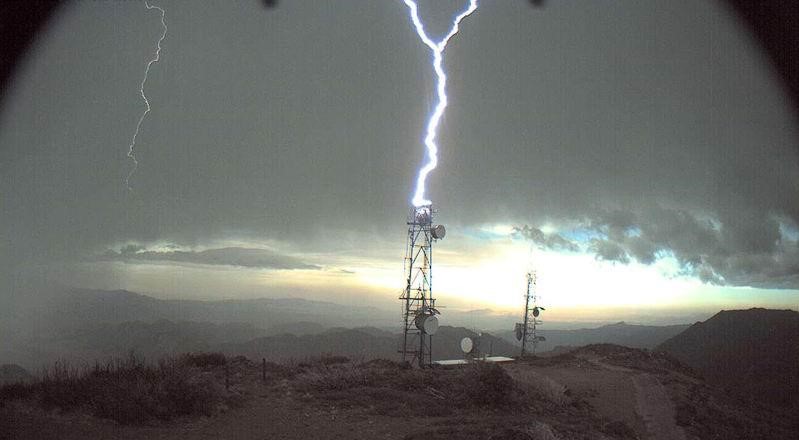
Lightning strikes can disable expensive communications equipment
During the design and operation of the tower, many contractors were replaced, but there were no specific persons responsible for lightning protection. After 10 years of losses totaling about $ 2 million, it was decided to explore the problem. As a result, it was discovered that the lightning protection of the tower had many details that were not taken into account.
As it turned out, under the tower there is soil of fine-grained silica that provided good drainage, but had very poor conductivity. Poor soil and lack of maintenance of chemical grounding electrodes for 10 years led to the fact that the resistance of the ground of the site under grounding exceeded 1000 Ohms. Moreover, it turned out that the contractor simply buried copper strips underground, without connecting them to the grounding electrode that protects the tower and the premises with transmitters. Because of this, the grounding had a resistance of 550 Ohms - 22 times higher than the permissible norm. As a result, power surges bypassed the electrode and destroyed equipment. Corrosion of steel conductors on the tower also sharply increased resistance and made lightning protection ineffective.
In the equipment room, the metal equipment racks were connected to ground, but the equipment chassis with a total value of $ 2 million were not grounded to the racks, that is, it was grounded only through power cords. All this led to the fact that discharges of current from lightning slipped through wet concrete, "burning out" the electronics.
All these factors weakened lightning protection and in common led to permanent outages and expensive repairs.
The new lightning protection for the tower was developed more carefully, and on the basis of equipment, that is, with an emphasis on maintaining the operability of transmitters for any number of lightning strikes. It was necessary to fix the problem with a minimum of work on rebuilding the tower, and as a result, they managed to meet the sum of $ 150,000 that at first sight was expensive, but fully paid off in just two years.
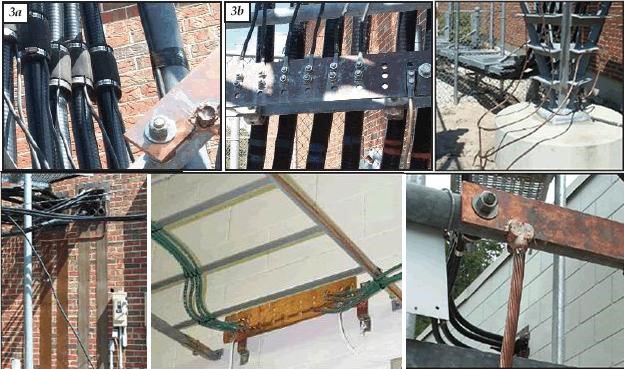
Lightning protection had to be enhanced with additional elements
Engineers decided to complement the existing lightning protection. First of all, a new 18-meter grounding electrode with a resistance of 4.3 Ohms was installed in the ground. New copper buses located on the tower, with the help of copper wires 14 mm in diameter, were connected to this grounding electrode. New ones were added to the old buses, and additional copper wires connected to the new electrodes with resistance from 5.3 to 6.7 Ohms were stretched along the cables supporting the tower. The equipment chassis was connected to the racks with a copper wire with a diameter of 7.6 mm, and the racks themselves were placed on rubber mats. The rusted conductors between the tower and the building were replaced with 6.3 mm thick copper plates with a welded connection of wires.
In total, five electrodes were buried in the ground at 37 m, connected by a grounding copper ring from a wire with a diameter of 1.4 cm. As a result, the equipment room and the tower were enclosed in a lightning protection “cage” with grounding conductors around the perimeter of the building.
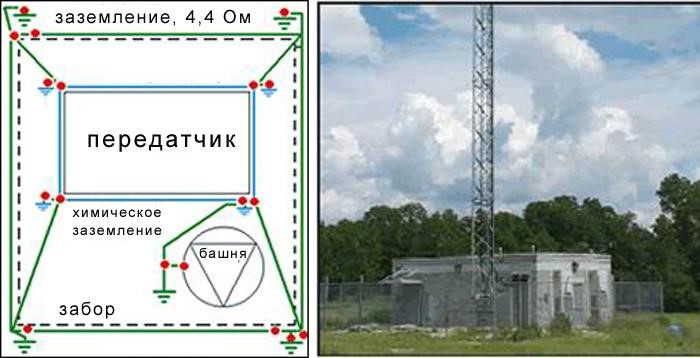
New grounding scheme. Tower and building with equipment protected around the perimeter
Заземление - Grounding
Передатчик - Transmitter
Химическое заземление - Chemical grounding
Башня - Tower
Забор - Fence
The modernization was carried out in 2002, and since then the “magic ring” of the new lightning protection reliably protects equipment from thunderstorms, the intensity of which is growing every year.
Golf course lightning protection
The golf course at first sight is not an object for which lightning is a serious danger, because in a thunderstorm players leave the field. However, lightning is one of the main threats to the field infrastructure, and the lightning protection of these objects is always unique.
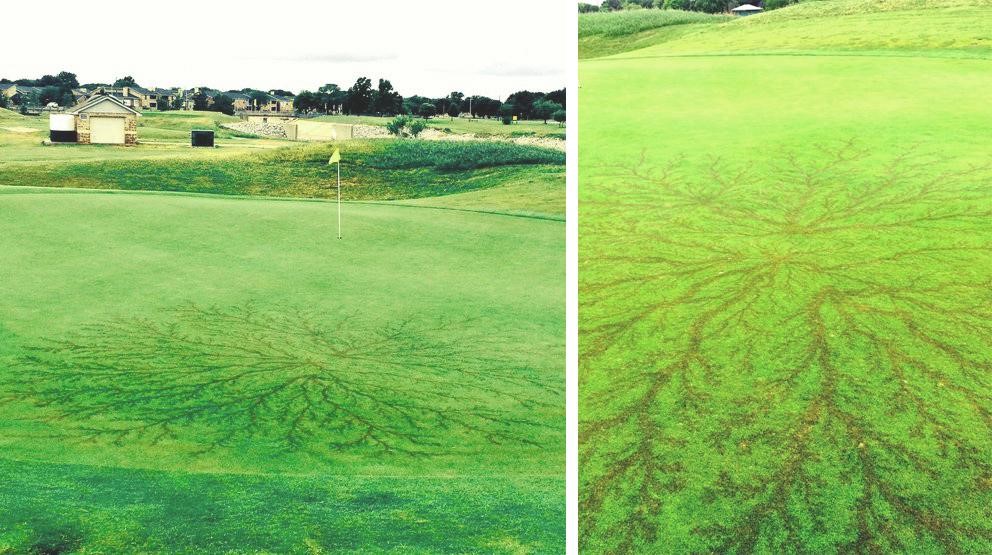
Previously, lightnings only damaged the lawn, but today they threaten expensive equipment hidden under the turf
The fact is that golf courses are equipped with irrigation systems that provide high quality turf. The highest quality golf courses have very complex “smart” systems with automatic watering, electronic sensors for soil moisture, turf quality control, etc. Such systems can be wireless with support for up to 500 sensors and remote control via cloud systems and 3G / 4G communications. It is impossible to provide a comfortable game without such systems, but at the same time, the saturation with electronics increases the vulnerability to lightning strikes. There are no simple solutions to this problem: the "picket fence" of lightning rods will interfere with the game and violate the aesthetics of the field, in addition, grounding can damage sensors buried in the ground. Each field also has an original design, and it is impossible to create a standardized solution for lightning protection.
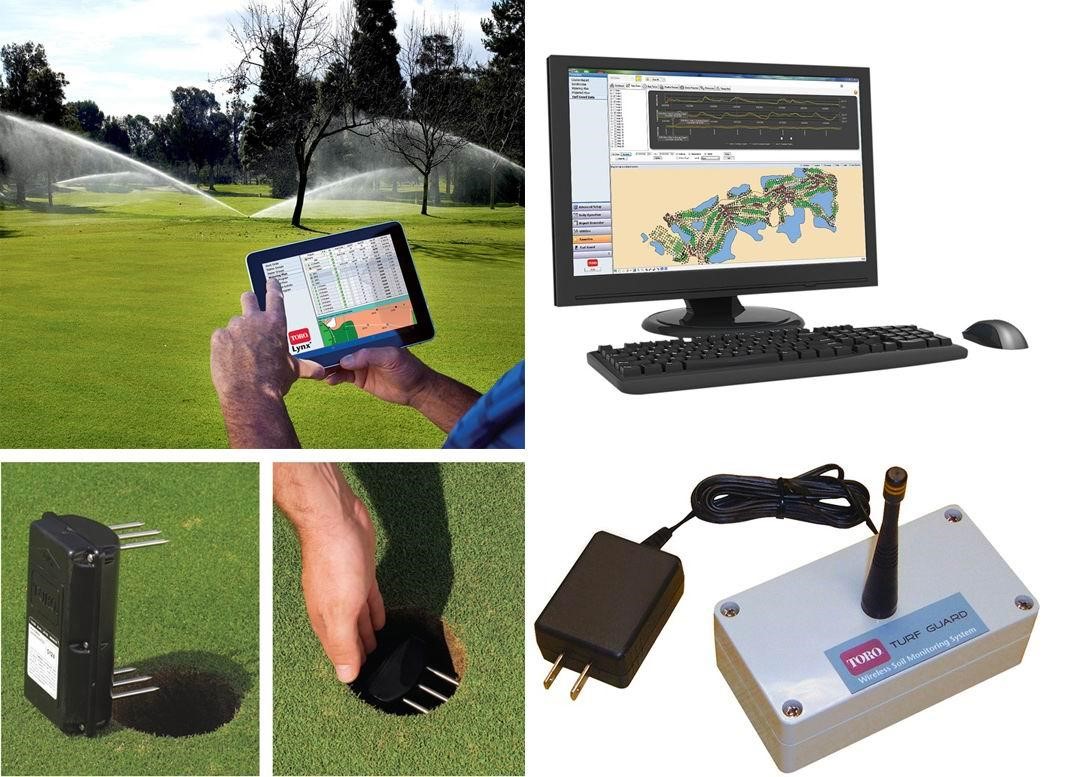
Golf courses are electronically powered and use automated remote access control systems
Irrigation systems with a network of pipelines, sprinklers and powerful, expensive pumps are the most vulnerable golf course infrastructure for lightning. The irrigation network acts like a large antenna and is very sensitive to sudden surges in voltage from a lightning strike. Sensors, controllers, pumping stations fail. In addition, power surges can damage the control system and satellite communications that disrupts the irrigation process and requires laborious repair work. Ultimately, the field loses money, since it is impossible to play during the repair period.
Several “defense lines” are used to protect golf course irrigation systems. First of all, surge suppressors are widely used, the so-called lightning protection that redirects excess charge to external ground in the case when the voltage is above normal.
However, studies have shown that lightning reaches a peak current during the first microseconds of strike. In the field, conventional surge suppressors do not have time to respond to such instantaneous events. In this regard, metal oxide varistors (MOV) and spark gap arresters are used on golf courses.
When a particularly intense lightning with a voltage of 30 million volts, which MOV cannot cope with, strikes, lightning arresters come into play, directing the excess current to the ground, and not to the electronic components. Thus, fast MOVs respond to a sudden surge in voltage, and the arresters dissipate current.
Unfortunately, this is not enough, because such protection does not work until the power surge is in the wiring connected to the equipment. In addition, it has a limited service life and can withstand only a certain number of strokes. It is also possible that protective devices can transmit a dangerous power surge from the ground wire.
Therefore, the following line of defense is used: turning off the equipment as the most reliable way to avoid damage from lightning strikes. On the golf course, quick and safe manual disconnection in thunderstorms is not possible. In addition, irrigation systems are too complex for such a procedure. Therefore, an active automatic shutdown system is used, associated with sensors that detect a thunderstorm through a radio burst. Typically, lightning detectors are carried from the field for 2-3 km to a place with a minimum of radio interference.
In most cases, it is necessary to use several autonomous automatic protection units that protect the key elements of a smart infrastructure: control system, satellite controllers, and pumping station equipment. Each unit has its own automatic circuit breaker that disconnects the AC sources, weather station, communication lines and other equipment. To exclude breakdown or spark discharge, the circuit breakers are shunted and grounded.
As soon as the thunderstorm is over, the system waits for at least 6 minutes, and if there is no lightning, it turns on all the equipment again, and the golf course begins to function normally.
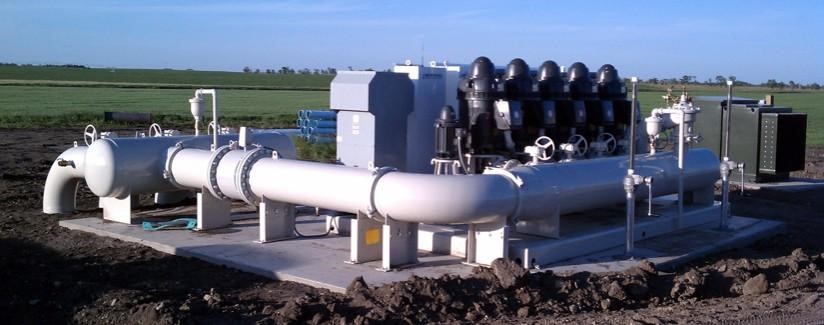
Pumping equipment is most vulnerable to lightning strikes
A particular problem is the pumping equipment, since the controller must operate for at least 30 seconds to relieve pressure in the system before shutting it down. All this time, the system is extremely vulnerable to lightning. It is impossible to completely eliminate the risk, the only thing that can be done is to try to detect lightning in advance and calculate the optimal shutdown time.
Thus, reliable lightning protection of a golf course is a very difficult engineering task. In each case, a unique configuration is created with the arrangement of sensors and grounding. At the same time, a feature is the need for constant monitoring of the grounding efficiency. On the golf courses there are areas with turf, sand, ponds, hills and lowlands, so you need to take into account the different conductivity of the soil when installing grounding.
The problems described above apply to all modern irrigation systems installed in open ground. In agriculture, “smart” systems for monitoring the state of the soil and vegetation, combined with automatic equipment for irrigation, fertilizers and satellite communication systems, are becoming more widespread. Accordingly, the experience of lightning protection of golf courses is widely used.
Lightning protection of power transmission lines in a forest area
Power transmission lines surrounded by dense vegetation are a complex facility for operation. Tree branches lead to short circuits and wire breakage, especially during strong winds. The problem is relevant for all regions of the planet covered by forests, but in some cases lightning protection plays a key role in choosing the way to organize power lines.
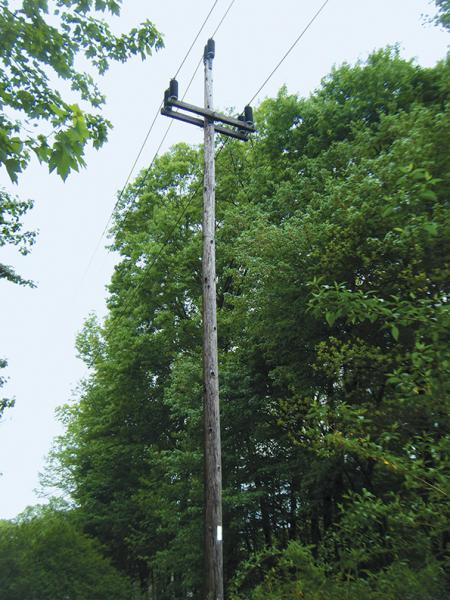
Power transmission line support in forest area
In 2011, a series of storms took place in East Longmeadow, Massachusetts, USA, that led to prolonged blackouts on power transmission lines with a voltage of 69 kV. The wind traveled along the cutting strip and power transmission poles, throwing broken branches and trees onto the wires. After these events, it was decided to modernize the line with a length of 19.3 km.
The power transmission line was old with high wooden supports (up to 16.7 m) and was located in a narrow cutting area of 18.3 m. At the same time, the line is surrounded by pines more than 30 m high, that is, the protective strip is too narrow to protect the wires. As a result, disconnecting the substation during strong winds has become commonplace.
The simplest solution would be to expand the forest corridor, but the forest around the power lines belongs to many owners. The next option was to increase the height of Power transmission line supports and raise wires above the trees. However, during the calculations it turned out that the requirements for lightning protection in this case will increase sharply. Typically, wooden supports of power transmission lines with voltages up to 35 kV do not require lightning wire rope along the entire length. Moreover, according to the results of many studies, it is known that the number of power transmission line disconnections passing through forests is less than the predicted values. This is due to the fact that the forest protects power transmission lines from lightning strikes, and up to 90% of damage to overhead power transmission lines is associated with strong winds and icing, while in open areas up to 80% of blackouts occur in thunderstorms.
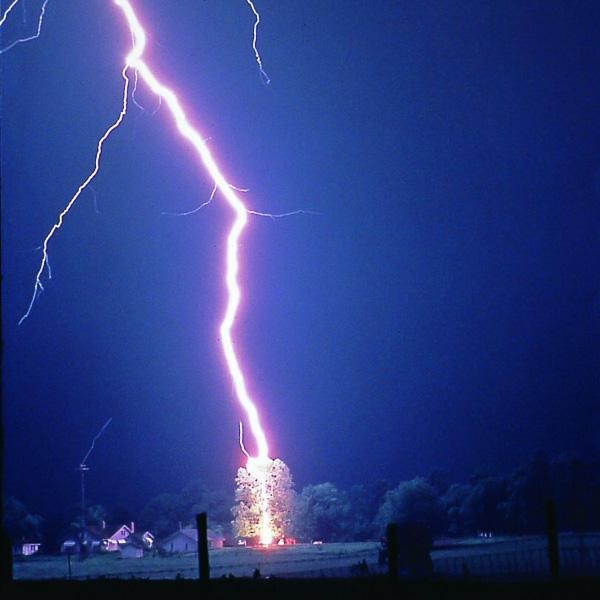
Trees are a natural lightning conductor, so power transmission lines below the tree crowns are better protected
On the power transmission line in East Longmeadow there protection of the supports was only from the direct lightning strikes. Raising the power transmission line support above the tree top will deprive the natural lightning protection of supports from the forest and will require the use of cable protection that, in turn, requires even higher supports and even greater horizontal phase-to-phase distance. As a result, the design turned into a large-scale expensive construction and did not fit into the strip of land allotted for power transmission lines.
It was not possible to find an acceptable method of lightning protection. Designers examined numerous solutions and came to the conclusion that the line in the forest should be left below the trees. As a result, to protect against cliffs and icing, they chose the spacer cable scheme developed by Hendrix. It consists of three insulated cables and an overhead wire (“messenger”) that provides mechanical support for phase cables, protects against falling branches and trees, and also acts as lightning protection. Cables are mounted on polymer struts with nylon bolts and protected by several layers of insulation. On all supports where bare wires were connected to insulated, arresters were installed to protect against lightning.
The spacer cable design is very compact compared to conventional bare wires on metal supports with wide traverses. Hendrix power transmission lines effectively dampen vibrations of wires, withstand repeated touches of branches and even the fall of small trees. Thanks to this, the operation of such power transmission lines is cheaper, including reducing the cost of pruning trees by 30-80% Also, unlike the design with a self-supporting phase cable, a messenger cable is used to support the spacer that reduces the wind load and the mass of the power transmission lines.
The spacer cable has disadvantages: the difficulty of installing hard cables, high requirements for design quality, materials and installation, as well as lightning protection.

New supports with spacer cable and arresters on supports with bare wires
The modernization of the line was completed in December 2015, and since then there have been no problems with it. Such three-phase 69 kV power transmission lines with a spacer cable are a relatively new technology for the United States and are used only in a few places. The power transmission line in East Longmeadow was the first in the Northeastern of the United States. Government experts monitor the line, and if its operation is successful, they use the experience on other power transmission lines that are constantly faced with the problem of blackouts due to falling branches and trees on the wires.
Do you need help in designing or choosing equipment for grounding and lightning protection? Contact the ZANDZ.com Technical Center!
See also:
- Examples of grounding solutions for critical objects
- Soil resistivity table
- Grounding and Lightning Protection Designs
Related Articles:




